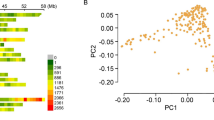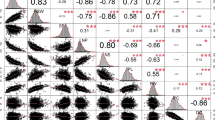Abstract
We have previously reported an association between a single nucleotide polymorphism (SNP) in exon 10 of GmBADH2 gene and fragrance in vegetable soybean [Glycine max (L.) Merr.] cultivar Kaori. The SNP causes amino acid substitution in a highly conserved motif of GmBADH2 protein, which is necessary for functional activity of the protein. In this study, we sequenced GmBADH2 in another fragrant soybean cultivar Chamame and discovered a new fragrance allele, which has a 2-bp (TT) deletion in exon 10. The deletion causes a reading frame shift and introduces a premature stop codon, which could abolish protein function and result in fragrance. The old and new fragrance-promoting alleles were designated Gmbadh2-1 and Gmbadh2-2, respectively. A simple and co-dominant functional marker was developed for genotyping Gmbadh2-2. The marker can discriminate between fragrant and non-fragrant soybeans and distinguish the two different fragrant soybeans, and thus is useful for routine genotyping for the fragrance trait in breeding programs. Quantitative trait locus (QTL) mapping in an F2 population using Chamame as the fragrance donor revealed that the location of the fragrance QTL nearly coincided with that of the functional marker, confirming the association between GmBADH2 and fragrance in Chamame.






Similar content being viewed by others
References
Amarawathi Y, Singh R, Singh AK, Singh VP, Mohapatra T, Sharma TR, Singh NK (2008) Mapping of quantitative trait loci for basmati quality traits in rice (Oryza sativa L.). Mol Breeding 21(1):49–65
AVRDC (2003) AVRDC progress report 2002. AVRDC—The World Vegetable Center, Shanhua
Bradbury LMT, Henry RJ, Jin QS, Reinke RF, Waters DLE (2005a) A perfect marker for fragrance genotyping in rice. Mol Breed 16:279–283
Bradbury LMT, Fitzgerald TL, Henry RJ, Jin QS, Water DLE (2005b) The gene for fragrance in rice. Plant Biotechnol J 3:363–370
Buttery RG, Juliano BO, Ling LC (1983a) Identification of rice aroma compound 2-acetyl-1-pyrroline in pandan leaves. Chem Ind 23:478
Buttery RG, Ling LC, Juliano BO, Turnbaugh JG (1983b) Cooked rice aroma and 2-acetyl-1-pyrroline. J Agric Food Chem 31:823–826
Chen S, Yang Y, Shi W, Ji Q, He F, Zhang Z, Cheng Z, Liu X, Xu M (2008) Badh2, encoding betaine aldehyde dehydrogenase, inhibits the biosynthesis of 2-acetyl-1-pyrroline, a major component in rice fragrance. Plant Cell 20:1850–1861
Drenkard E, Richter BG, Rozen S, Stutius LM, Angell NA, Mindrinos M, Cho RJ, Oefner PJ, Davis RW, Ausubel FM (2000) A simple procedure for the analysis of single nucleotide polymorphisms facilitates map-based cloning in Arabidopsis. Plant Physiol 124:1483–1492
Fehr WR, Caviness CE (1977) Stages of soybean development. Iowa State University of Science and Technology Special Report 80
Fushimi T, Masuda R (2001) 2-Acetyl-1-pyrroline concentration of the vegetable soybean. In: Lumpkin T, Shanmugasundaram S (eds) Proceedings of the 2nd international vegetable soybean conference. Washington State University, Pullman, Washington, USA, p 39
Godhi MA, Ye GN, Weeden NF, Reisch BI (1994) A simple and efficient method for DNA extraction from grapevine cultivars and Vistis species. Plant Mol Biol Rep 12:6–13
Grant D, Nelson RT, Cannon SB, Shoemaker RC (2010) SoyBase, the USDA-ARS soybean genetics and genomics database. Nucleic Acids Res 38(suppl 1):D843–D846
Hall TA (1999) BioEdit: a user-friendly biological sequence alignment editor and analysis program for Windows 95/98/NT. Nucleic Acids Symp Ser 41:95–98
Juwattanasomran R, Somta P, Chankaew S, Shimizu T, Wongpornchai S, Kaga A, Srinives P (2010) A SNP in GmBADH2 gene associates with fragrance in vegetable soybean variety “Kaori” and SNAP marker development for the fragrance. Theor Appl Genet. doi:10.1007/s00122-010-1467-6
Kovach MJ, Calingacion MN, Fitzgerald MA, McCough SR (2009) The origin and evolution of fragrance in rice (Oryza sativa L.). Proc Natl Acad Sci USA 106:14444–14449
Niu X, Tang W, Huang W, Ren G, Wang Q, Luo D, Xiao Y, Yang S, Wang F, Lu BL, Gao F, Lu T, Liu Y (2008) RNAi-directed downregulation of OsBADH2 results in aroma (2-acetyl-1-pyrroline) production in rice (Oryza sativa L.). BMC Plant Biol 8:100
Rozen S, Skaletsky HJ (2000) Primer3 on the WWW for general users and for biologist programmers. In: Krawetz S, Misener S (eds) Bioinformatics methods and protocols: methods in molecular biology. Humana Press, Totowa, pp 365–386
Shanmugasundaram S, Cheng ST, Huang MT, Yan MR (1991) Quality requirement and improvement of vegetable soybean. In: Shanmugasundaram S (ed) Vegetable soybean: research needs for production and quality improvement. Asian Vegetable Research and Development Center, Shanhua, pp 30–42
Shi W, Yang Y, Chen S, Xu M (2008) Discovery of a new fragrance allele and the development of functional markers for the breeding of fragrant rice varieties. Mol Breed 22:185–192
Van Ooijen JW (2006) JoinMap® 4, Software for the calculation of genetic linkage maps in experimental populations. Kyazma B.V., Wageningen
Wanchana S (2005) Identification of genes controlling grain aroma and amylose content for positional cloning and marker-assisted selection program in rice (Oryza sativa L.). Ph.D. Thesis, Kasetsart University, Thailand
Wang S, Basten CJ, Zeng ZB (2007) Windows QTL Cartographer 2.5. Department of Statistics, North Carolina State University, Raleigh, NC, USA
Wongpornchai S, Sriseadka T, Choonvisase S (2003) Identification and quantification of the rice aroma compound, 2-acetyl-1-pyrroline, in bread flowers (Vallaris glabra Ktze). J Agric Food Chem 51:457–462
Acknowledgments
This research was supported by the Thailand Research Fund (TRF), Thailand and the Center for Advanced Studies for Agriculture and Food Research of Kasetsart University. We thank the Center for Agricultural Biotechnology of Kasetsart University, Kamphaeng Saen Campus for laboratory facilities.
Author information
Authors and Affiliations
Corresponding author
Additional information
The authors R. Juwattanasomran and P. Somta contributed equally to this research.
Electronic supplementary material
Below is the link to the electronic supplementary material.
Rights and permissions
About this article
Cite this article
Juwattanasomran, R., Somta, P., Kaga, A. et al. Identification of a new fragrance allele in soybean and development of its functional marker. Mol Breeding 29, 13–21 (2012). https://doi.org/10.1007/s11032-010-9523-0
Received:
Accepted:
Published:
Issue Date:
DOI: https://doi.org/10.1007/s11032-010-9523-0




